We were quite excited to be headed back to Portugal. It is no secret that this country has risen to the top of our list of possible places to settle down. We were very keen to see if we enjoyed other towns in Portugal as much as we did Lagos.
What made the trip even more exciting was the fact that we got to meet up with friends while we were there. So off we set from Croatia and after a couple of flights arrived in Lisbon. We decided to stay in a hotel for the first night and arrived midday for lunch for a much-needed nap.
After a rest and a shower, we headed out to meet our good fiends, Iain and Ruth. One our many favorite things about this couple is that we are so simpatico that even though we have not seen (or spoken to) them in years, we fall right back in as if we just saw them yesterday. George worked with Ruth in the early days of BellSouth and later with Iain at T-Mobile. When they invited us to their wedding in Turkey years ago, we don’t think they really thought we would come, but we did and had a great time.
couple is that we are so simpatico that even though we have not seen (or spoken to) them in years, we fall right back in as if we just saw them yesterday. George worked with Ruth in the early days of BellSouth and later with Iain at T-Mobile. When they invited us to their wedding in Turkey years ago, we don’t think they really thought we would come, but we did and had a great time.
Our visit with Iain and Ruth had a bonus, we got to catch up with many members of Ruth’s family, as well as Ian’s best friend. Everyone was in town for Ruth’s brother’s birthday celebration. We had an amazing seafood dinner and a wonderful visit.
The next day we got up packed up and headed to the train station to meet our dear friends Leslie and Becky. We met up at the station and hopped on the comfort car of the train for an enjoyable 3 hour ride to Porto. Leslie and Becky have been a constant part of our lives since we met them in Atlanta 16 years ago. They live in St. Pete Beach Florida, and if you check out driver’s licenses you will find that
them in Atlanta 16 years ago. They live in St. Pete Beach Florida, and if you check out driver’s licenses you will find that  we all share the same address. Allowing us to use their house as a home base is just one of the many things these two amazing people do to support our traveling life.
we all share the same address. Allowing us to use their house as a home base is just one of the many things these two amazing people do to support our traveling life.
From the train station we headed to our Airbnb in Porto, a large well-appointed place where we all settled in quickly. Everyone was a bit travel weary, but we still managed to have a lovely dinner down on the river that evening.
 Our first stop on the tourist route was the Livaria Lello, which is an amazing
Our first stop on the tourist route was the Livaria Lello, which is an amazing  bookstore that was known to be frequented by J.K. Rowling. Once you visit it is easy to see that this location was clearly the influence for “Flourish and Blotts” the best bookstore in Diagon Alley. The combination of NeoGothic style and amazing woodwork takes your breath away. But what really catches your eye is the hand carved wooden stairway. When you are on it, one can easily imagine that you are on the grand staircase at Hogwarts, and you can’t help but wonder if it is about to suddenly change configuration like the one in the books did.
bookstore that was known to be frequented by J.K. Rowling. Once you visit it is easy to see that this location was clearly the influence for “Flourish and Blotts” the best bookstore in Diagon Alley. The combination of NeoGothic style and amazing woodwork takes your breath away. But what really catches your eye is the hand carved wooden stairway. When you are on it, one can easily imagine that you are on the grand staircase at Hogwarts, and you can’t help but wonder if it is about to suddenly change configuration like the one in the books did.
It would be impossible to describe a trip to Porto without talking about the food. Mornings are a chance to get espresso and a Portuguese specialty called Pastel De Nata. And between the four of us, we tried a lot of them looking for the perfect creamy egg custard nestled in a flaky crust cup. Some were better than others, but most were delicious and we had a lot of fun looking for the best.
to get espresso and a Portuguese specialty called Pastel De Nata. And between the four of us, we tried a lot of them looking for the perfect creamy egg custard nestled in a flaky crust cup. Some were better than others, but most were delicious and we had a lot of fun looking for the best.
 Another staple of Porto cuisine is the francesinha sandwich (Little Frenchie in Portuguese). This over-the-top sandwich contains sliced sirloin steak and Portuguese sausage, served on crunchy sourdough bread, smothered in a thick layer of cheese and swimming in a tomato and beer sauce. It might sounds sketchy but trust us – it is fantastic. The best ones are topped with a fried egg. Imagine if an amazing steak sandwich and a perfect French onion soup got married and had a baby….
Another staple of Porto cuisine is the francesinha sandwich (Little Frenchie in Portuguese). This over-the-top sandwich contains sliced sirloin steak and Portuguese sausage, served on crunchy sourdough bread, smothered in a thick layer of cheese and swimming in a tomato and beer sauce. It might sounds sketchy but trust us – it is fantastic. The best ones are topped with a fried egg. Imagine if an amazing steak sandwich and a perfect French onion soup got married and had a baby….
 Porto of course is known for its fortified wines or Ports. Bonnie made arrangement for us all to be picked up for a day
Porto of course is known for its fortified wines or Ports. Bonnie made arrangement for us all to be picked up for a day touring the Douro River Valley, to learn about Ports and the other wines there. We toured two lovely wineries, which were very small by California standards, and enjoyed tasting a lot of different types of wine and Ports. We also enjoyed a river barge cruise down the river to see the sights.
touring the Douro River Valley, to learn about Ports and the other wines there. We toured two lovely wineries, which were very small by California standards, and enjoyed tasting a lot of different types of wine and Ports. We also enjoyed a river barge cruise down the river to see the sights.
All too soon it was time for us to pack up and leave delightful Porto. But the good news was that we still had to more days to spend with Leslie and Becky exploring Lisbon. We all hopped on the train and headed back.
One of the fun things about an Airbnb is that you really don’t know what to expect, sometimes the residences can be fun and quirky and our place in Lisbon certainly did not disappoint. Tucked into a historic building in the Alfama district of Lisbon, this apartment was beyond eclectic, right down to a combination bicycle and bulls head that adorned the wall. The location was an excellent central spot for us to use as a base for exploring. We wandered for miles, tasting more pastel de nata, and generally got to know Lisbon.
and quirky and our place in Lisbon certainly did not disappoint. Tucked into a historic building in the Alfama district of Lisbon, this apartment was beyond eclectic, right down to a combination bicycle and bulls head that adorned the wall. The location was an excellent central spot for us to use as a base for exploring. We wandered for miles, tasting more pastel de nata, and generally got to know Lisbon.
After an amazing week together, we loaded Leslie and Becky into an Uber bound for the airport and home. This next day we made the same trek on our way to Penang Malaysia.
Portugal was everything we hoped it would be, the style, the vibe, the food and friends.
We will be back!





 Adriatic Sea bordered by Hungary and Slovenia to the North and Bosnia-Herzegovina to the South. Our travels took us to the lovely seaside tourist town of Split (43.508 N, 16.440 E).
Adriatic Sea bordered by Hungary and Slovenia to the North and Bosnia-Herzegovina to the South. Our travels took us to the lovely seaside tourist town of Split (43.508 N, 16.440 E).

 The Golden Gate of the Palace is guarded by a huge statue of Bishop
The Golden Gate of the Palace is guarded by a huge statue of Bishop 
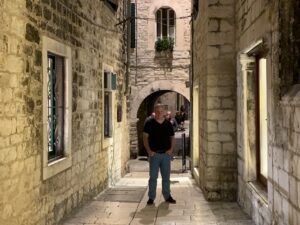
 Since our
Since our  fruit and vegetables from the daily outdoor Green Market just outside the palace. We had a great time shopping for fresh produce, locally grown honey, fresh baked bread and cheeses.
fruit and vegetables from the daily outdoor Green Market just outside the palace. We had a great time shopping for fresh produce, locally grown honey, fresh baked bread and cheeses. About halfway through the tour we were lucky enough to catch up with our dear friends Art and Jacqueline Shand, who were in Split for one night of a world wind gastronomic tour of Croatia and Italy. It was such a pleasure to see them, visit for a few hours and share a lovely dinner.
About halfway through the tour we were lucky enough to catch up with our dear friends Art and Jacqueline Shand, who were in Split for one night of a world wind gastronomic tour of Croatia and Italy. It was such a pleasure to see them, visit for a few hours and share a lovely dinner.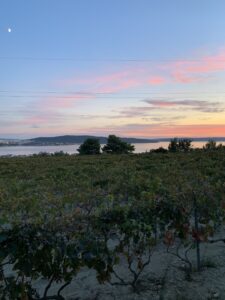 wineries. Our vino connoisseur friends might be surprised to learn the unique strain of Zinfandel grapes so long credited with origin in Northern California have been traced to right here in Split. If you get a chance to take the winemakers tour at
wineries. Our vino connoisseur friends might be surprised to learn the unique strain of Zinfandel grapes so long credited with origin in Northern California have been traced to right here in Split. If you get a chance to take the winemakers tour at 



 They accompanied us pretty much everywhere we went, woke us up by jumping in bed with us in the morning and generally demanded love and attention which we were happy to give.
They accompanied us pretty much everywhere we went, woke us up by jumping in bed with us in the morning and generally demanded love and attention which we were happy to give.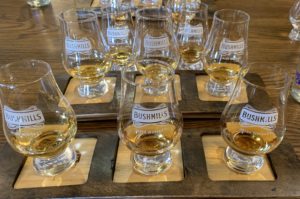 Of course we had to visit the
Of course we had to visit the  Since we are on the topic of drinks, we should mention the amazing pints of
Since we are on the topic of drinks, we should mention the amazing pints of 

 We had an amazing time hanging out with Socks and Beau, thanks again to our hosts Judy and Tim Nelson.
We had an amazing time hanging out with Socks and Beau, thanks again to our hosts Judy and Tim Nelson.

 house where we are pet sitting in
house where we are pet sitting in  where the similarities end. Instead of racking off the “green” fermented liquid and carbonating it to make beer, the liquid is distilled.
where the similarities end. Instead of racking off the “green” fermented liquid and carbonating it to make beer, the liquid is distilled.
 need look at their money. On the back of each 5 and 10 pound note is an image of the barrel house on the distillery grounds.
need look at their money. On the back of each 5 and 10 pound note is an image of the barrel house on the distillery grounds.
 This program is for people who have a real desire to improve their English; to immerse themselves in the language. One way to do this is to travel to a country where only English is spoken. Another way is to become part of a program that offers immersion without the international travel.
This program is for people who have a real desire to improve their English; to immerse themselves in the language. One way to do this is to travel to a country where only English is spoken. Another way is to become part of a program that offers immersion without the international travel. course to control the environment we needed to be in an enclave of sorts, so we all jumped on a bus in Frankfurt and headed to a secluded country hotel (
course to control the environment we needed to be in an enclave of sorts, so we all jumped on a bus in Frankfurt and headed to a secluded country hotel (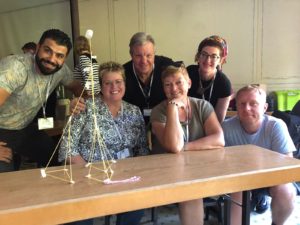 The week started off with a round of introductions, in the form of a fun game. From there we proceeded to spend the next five days one on one, in groups, on teams,on phone calls with students and at meals speaking English. We sang, we danced, we played games, we hiked, we created an acted in small theater productions and we gave/attended presentations.
The week started off with a round of introductions, in the form of a fun game. From there we proceeded to spend the next five days one on one, in groups, on teams,on phone calls with students and at meals speaking English. We sang, we danced, we played games, we hiked, we created an acted in small theater productions and we gave/attended presentations.

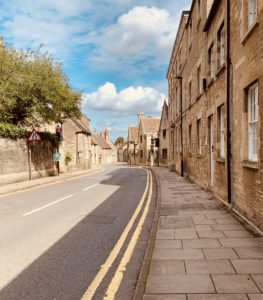 been for the invitation from Lance and Adrian (Ady) to come look after their home and pets while they visited family in Canada. Lance is a landscape designer, so you can imagine how amazing the gardens around the house were. Adrian is a retired flight attendant with lots of great stories about his travels. They have a dog named Georgie and a cat named Alfie who are both amazing and full of personality.
been for the invitation from Lance and Adrian (Ady) to come look after their home and pets while they visited family in Canada. Lance is a landscape designer, so you can imagine how amazing the gardens around the house were. Adrian is a retired flight attendant with lots of great stories about his travels. They have a dog named Georgie and a cat named Alfie who are both amazing and full of personality. enjoy things like grocery shopping (which is unique in every country). Oundle is a small town that sports 3 grocery stores, two butchers and a handful of pubs. By the time we left, George was on a first name basis with the butcher and while he was getting a hair cut the barber said, “so I understand you are house sitting for Lance and Ady”. Such is life in a very small town.
enjoy things like grocery shopping (which is unique in every country). Oundle is a small town that sports 3 grocery stores, two butchers and a handful of pubs. By the time we left, George was on a first name basis with the butcher and while he was getting a hair cut the barber said, “so I understand you are house sitting for Lance and Ady”. Such is life in a very small town. group of friends who pal around, share dinners, support each other in ride sharing and projects and just enjoy each other’s company in general. While we were no substitute for Lance and Ady, we certainly had fun hanging out with their friends.
group of friends who pal around, share dinners, support each other in ride sharing and projects and just enjoy each other’s company in general. While we were no substitute for Lance and Ady, we certainly had fun hanging out with their friends. Many of these are created in cooperation with local farmers. This allows you to take long walks through fields and along the river. You can never tell if you will be in the
Many of these are created in cooperation with local farmers. This allows you to take long walks through fields and along the river. You can never tell if you will be in the  middle of a heard of cows (or sheep) or walking down a country road.
middle of a heard of cows (or sheep) or walking down a country road.
 those of you who have not yet created this delicacy, the rest of this article is dedicated to a detailed explanation of how George does it. Note that before we sold everything and headed out to wander the world, George had a large pellet smoker and could smoke 50 pounds (22.7 kilos) of pork at a time. In England, we had fewer people to feed and a regular gas grill, some adjustments had to be made.
those of you who have not yet created this delicacy, the rest of this article is dedicated to a detailed explanation of how George does it. Note that before we sold everything and headed out to wander the world, George had a large pellet smoker and could smoke 50 pounds (22.7 kilos) of pork at a time. In England, we had fewer people to feed and a regular gas grill, some adjustments had to be made.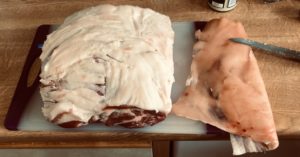 them to leave as much of the layer of fat (called a fat cap) between the skin and the meat as possible. The fat cap will help add moisture to the meat as it cooks down during the smoking process. Because we will be cooking this meat for many hours at a low temperature (low and slow) it is important to keep it from becoming dry. The fat cap will help, but there are also other steps we can take. This first is a process called brining, in essence, we will be soaking the meat in salt water. The salt helps the liquid be absorbed by the meat and it also helps add flavor
them to leave as much of the layer of fat (called a fat cap) between the skin and the meat as possible. The fat cap will help add moisture to the meat as it cooks down during the smoking process. Because we will be cooking this meat for many hours at a low temperature (low and slow) it is important to keep it from becoming dry. The fat cap will help, but there are also other steps we can take. This first is a process called brining, in essence, we will be soaking the meat in salt water. The salt helps the liquid be absorbed by the meat and it also helps add flavor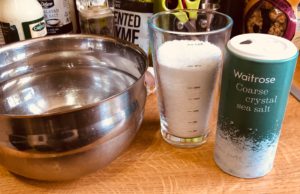 (double bonus). In a large container, mix about 2 cups of kosher salt and a cup of sugar into a gallon of water. Stir until all the solids are dissolved. Place the pork into a large plastic bag, pour the salt water over it, then work all of the air out of the bag and seal it shut with a strong twist tie. If you have enough room in the refrigerator you can put it there. I did not, so I put the whole thing in a small cooler with bag of ice to keep it cold. Brine the pork for between 24 and 30 hours.
(double bonus). In a large container, mix about 2 cups of kosher salt and a cup of sugar into a gallon of water. Stir until all the solids are dissolved. Place the pork into a large plastic bag, pour the salt water over it, then work all of the air out of the bag and seal it shut with a strong twist tie. If you have enough room in the refrigerator you can put it there. I did not, so I put the whole thing in a small cooler with bag of ice to keep it cold. Brine the pork for between 24 and 30 hours. George’s Butt Rub
George’s Butt Rub
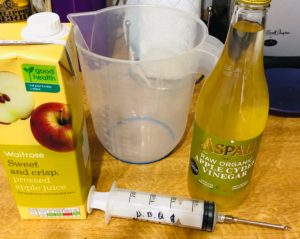 On the morning of the day you will be smoking the meat (remember this
On the morning of the day you will be smoking the meat (remember this process can take up to 9 hours), fill the metal pan in the grill with water. Place a generous hand full of the soaked apple chips in the chip tray and either light the charcoal in a chimney or light one burner on the grill. In the photo below, you can see that we placed to the chip tray to the far left and we only used a single burner on the far-left side of the grill (indirect heat). Warm the grill so that the temperature of a gauge where the meat will be placed reads 220 degrees F (104 degrees C). Don’t trust the thermometer built into the top of the grill, it does not give you and accurate reading of what is happening at where the meat is. We recommend using an oven thermometer.
process can take up to 9 hours), fill the metal pan in the grill with water. Place a generous hand full of the soaked apple chips in the chip tray and either light the charcoal in a chimney or light one burner on the grill. In the photo below, you can see that we placed to the chip tray to the far left and we only used a single burner on the far-left side of the grill (indirect heat). Warm the grill so that the temperature of a gauge where the meat will be placed reads 220 degrees F (104 degrees C). Don’t trust the thermometer built into the top of the grill, it does not give you and accurate reading of what is happening at where the meat is. We recommend using an oven thermometer. While the grill is heating, make a mixture of half (50%) apple juice and half apple cider vinegar. You will need about 4 cups (1 liter) of this mixture to complete the day. Unwrap the pork butt and place it fat side up in a large pan. Using a large syringe, inject about 1.5 to 2 cups (about ½ liter) of the mixture into the pork butt. Out at the grill, take the pork out of the pan, and place it (still fat side up) on the grates away from the heat source.
While the grill is heating, make a mixture of half (50%) apple juice and half apple cider vinegar. You will need about 4 cups (1 liter) of this mixture to complete the day. Unwrap the pork butt and place it fat side up in a large pan. Using a large syringe, inject about 1.5 to 2 cups (about ½ liter) of the mixture into the pork butt. Out at the grill, take the pork out of the pan, and place it (still fat side up) on the grates away from the heat source. McGee book (by John D. McDonald) and relax for a bit. For the
McGee book (by John D. McDonald) and relax for a bit. For the After two hours, unwrap the meat and put it back onto the rack on the grill. Continue to cook at 225 F and spray with your cider/vinegar mix every the half hour. After two hours, start checking the internal temperature of the meat when you spray. You are looking for an internal temperature of 169 F (76 degrees C) in all areas of the butt. Don’t worry if some areas get warmer, you will not overcook the meat. This final part of the cooking can take anywhere from 2 to 4 hours. Be patient, and do not be tempted to take the pork out before it reaches temp. If you do, it will make it nearly impossible to shred in the next step.
After two hours, unwrap the meat and put it back onto the rack on the grill. Continue to cook at 225 F and spray with your cider/vinegar mix every the half hour. After two hours, start checking the internal temperature of the meat when you spray. You are looking for an internal temperature of 169 F (76 degrees C) in all areas of the butt. Don’t worry if some areas get warmer, you will not overcook the meat. This final part of the cooking can take anywhere from 2 to 4 hours. Be patient, and do not be tempted to take the pork out before it reaches temp. If you do, it will make it nearly impossible to shred in the next step. aluminum foil. Allow it to rest and cool for at least one hour (preferable two) before removing the bone and shredding the meat. The shredding (or pulling at it is called) is easiest with a pair of forks. If you are planning on smoking a lot of pork, you may want to invest in a set of “
aluminum foil. Allow it to rest and cool for at least one hour (preferable two) before removing the bone and shredding the meat. The shredding (or pulling at it is called) is easiest with a pair of forks. If you are planning on smoking a lot of pork, you may want to invest in a set of “

 meet up with Hansen Alumni (or Fellows as they are called), and we have also been lucky enough to have been invited to several weddings. We recently attended one wedding in Israel
meet up with Hansen Alumni (or Fellows as they are called), and we have also been lucky enough to have been invited to several weddings. We recently attended one wedding in Israel  On the morning of first day of the wedding we were invited to tour
On the morning of first day of the wedding we were invited to tour  where Ramona’s grandmother lives. While waiting for the bride and groom we were treated to hand made doughnuts and cheese breads. We all crowded into a small country church, which was covered from floor to ceiling with amazing, hand painted bible scenes. When the couple and their chaperones arrived, we were all pleasantly surprised to see that they were dressed in traditional Romanian outfits. Ramona’s uncle, newly retired from his post as the villages’ priest, returned to the church to perform the engagement ceremony which was as filled with as much pageantry as most weddings.
where Ramona’s grandmother lives. While waiting for the bride and groom we were treated to hand made doughnuts and cheese breads. We all crowded into a small country church, which was covered from floor to ceiling with amazing, hand painted bible scenes. When the couple and their chaperones arrived, we were all pleasantly surprised to see that they were dressed in traditional Romanian outfits. Ramona’s uncle, newly retired from his post as the villages’ priest, returned to the church to perform the engagement ceremony which was as filled with as much pageantry as most weddings. With the engagement ceremony complete, everyone walked from the church through the village to Ramona’s grandmothers house for an amazing picnic lunch, full of hand-made food, home crafted brandies and liquor and a series of different meats grilled to perfection by Ramona’s dad, Vasile and his friends. We are told the party went on well into the night, we snuck off after several hours to greet the late travelers who had finally arrived at the hotel suite in Hunedoara.
With the engagement ceremony complete, everyone walked from the church through the village to Ramona’s grandmothers house for an amazing picnic lunch, full of hand-made food, home crafted brandies and liquor and a series of different meats grilled to perfection by Ramona’s dad, Vasile and his friends. We are told the party went on well into the night, we snuck off after several hours to greet the late travelers who had finally arrived at the hotel suite in Hunedoara. second day of the wedding was full on formal. I think everyone enjoyed getting spiffed up in suits and lovely dresses. The bus picked us up around noon and took us to the family home (where we had dinner two nights before). All the guest filled the street and generally stopped all traffic on the road in front of the house. Then we experienced another of the unique Romanian wedding traditions. The groom’s party, along with his male chaperone and his “spokesman” proceeded down the street, stopped at the house and knocked at the front door. The door was answered by the “spokesman” for the bride’s home. There is an initial exchange facilitated by drinking some very strong homemade liquor and then the formal negotiation. We will try to paraphrase the negotiation but please know that it was all in Romanian, some license may have been taken:
second day of the wedding was full on formal. I think everyone enjoyed getting spiffed up in suits and lovely dresses. The bus picked us up around noon and took us to the family home (where we had dinner two nights before). All the guest filled the street and generally stopped all traffic on the road in front of the house. Then we experienced another of the unique Romanian wedding traditions. The groom’s party, along with his male chaperone and his “spokesman” proceeded down the street, stopped at the house and knocked at the front door. The door was answered by the “spokesman” for the bride’s home. There is an initial exchange facilitated by drinking some very strong homemade liquor and then the formal negotiation. We will try to paraphrase the negotiation but please know that it was all in Romanian, some license may have been taken: The wedding itself took place in the Chapel of the Castle, despite the small size of the chapel, the ceremony was quite grand and included crowns for both the bride and groom. After the ceremony there were many photos on the grounds of the castle, and then onto the buses to head to the reception.
The wedding itself took place in the Chapel of the Castle, despite the small size of the chapel, the ceremony was quite grand and included crowns for both the bride and groom. After the ceremony there were many photos on the grounds of the castle, and then onto the buses to head to the reception. small dot of dry ice (the solid form of carbon dioxide) which made the champagne bubble and mist. This champagne was the first of many, many well thought out delights that added up to an amazing wedding reception. Other accents included a meal of five extremely robust courses, each was a treat all its’ own. In the hour or so break between each course there was traditional dancing, a photo booth, a clown and entertainment for the children, displays of sweets and nibbles and a full bar with a wide selection of mixed cocktails. After a cake cutting ceremony out in the
small dot of dry ice (the solid form of carbon dioxide) which made the champagne bubble and mist. This champagne was the first of many, many well thought out delights that added up to an amazing wedding reception. Other accents included a meal of five extremely robust courses, each was a treat all its’ own. In the hour or so break between each course there was traditional dancing, a photo booth, a clown and entertainment for the children, displays of sweets and nibbles and a full bar with a wide selection of mixed cocktails. After a cake cutting ceremony out in the courtyard, at almost midnight, the guests were treated to a private fireworks. All in all an amazing two days of celebrating the matrimony of Ramona and Jason.
courtyard, at almost midnight, the guests were treated to a private fireworks. All in all an amazing two days of celebrating the matrimony of Ramona and Jason. We would be remiss if we did not mention the gift bags that were given to each guest, one at arrival (full of all kinds of handy items and snacks) and one at the end of the event. Included in the bag that was handed out at the reception was a small bottle of brandy. It would be impossible for us to tell the story any better than the label on the bottle, so we have transcribed it below:
We would be remiss if we did not mention the gift bags that were given to each guest, one at arrival (full of all kinds of handy items and snacks) and one at the end of the event. Included in the bag that was handed out at the reception was a small bottle of brandy. It would be impossible for us to tell the story any better than the label on the bottle, so we have transcribed it below:
 There is so much to tell about our trip to Israel it is hard to know where to start, so let’s just take things in the order that they happened so we don’t miss any important details.
There is so much to tell about our trip to Israel it is hard to know where to start, so let’s just take things in the order that they happened so we don’t miss any important details. The whole reason we were in Israel is for the wedding of one of Bonnie’s Hansen students. We wanted to see Shelly (and Brian) as soon as possible so we decided to meet them at a beach bar a short walk from our place. Shelly was nice enough bring a box of wedding clothes (a suit for George, dress for Bonnie and nice shoes). Thanks again Becky for packing these up and getting them to us, we will send them back after the second wedding! After meeting the wedding couple and several of their friends, we wandered back to our place, hit the local supermarket and settled in for a quiet evening of dinner and Netflix at our flat.
The whole reason we were in Israel is for the wedding of one of Bonnie’s Hansen students. We wanted to see Shelly (and Brian) as soon as possible so we decided to meet them at a beach bar a short walk from our place. Shelly was nice enough bring a box of wedding clothes (a suit for George, dress for Bonnie and nice shoes). Thanks again Becky for packing these up and getting them to us, we will send them back after the second wedding! After meeting the wedding couple and several of their friends, we wandered back to our place, hit the local supermarket and settled in for a quiet evening of dinner and Netflix at our flat.
 Sunday was the day for the big wedding. Since it was not until the evening, we started the day with a wander through Jaffa, this is a mostly Christian (with a lot of Muslim mixed in) section of Tel Aviv and the sidewalks are lined with shops selling food, sweets, clothing and everything in between.
Sunday was the day for the big wedding. Since it was not until the evening, we started the day with a wander through Jaffa, this is a mostly Christian (with a lot of Muslim mixed in) section of Tel Aviv and the sidewalks are lined with shops selling food, sweets, clothing and everything in between. make an effort to get invited to one. There is so much symbolism and pageantry to it. The bride and groom stand under a canopy, known as a chuppah (pronounced hoop-a); this represents the home that the couple will build together. The rabbi or cantor “sings” the most of the ceremony in Hebre
make an effort to get invited to one. There is so much symbolism and pageantry to it. The bride and groom stand under a canopy, known as a chuppah (pronounced hoop-a); this represents the home that the couple will build together. The rabbi or cantor “sings” the most of the ceremony in Hebre The day after the wedding the family was kind enough to invite us for a us for a guided tour of Jerusalem. Your religion (of lack thereof) doesn’t matter. There is enough history and culture here to overwhelm almost
The day after the wedding the family was kind enough to invite us for a us for a guided tour of Jerusalem. Your religion (of lack thereof) doesn’t matter. There is enough history and culture here to overwhelm almost  anyone. We started at the Mount of Olives and looked out over the old city. There is a huge graveyard just outside the walls of the city. The Jews believe that when the messiah comes to earth he will walk though of the gates into the old city and the dead everywhere will rise and follow him into eternal life. So religious folks spend a small fortune to be buried close to the gate with their feet facing the old city. This makes it some of the most expensive real estate in the world.
anyone. We started at the Mount of Olives and looked out over the old city. There is a huge graveyard just outside the walls of the city. The Jews believe that when the messiah comes to earth he will walk though of the gates into the old city and the dead everywhere will rise and follow him into eternal life. So religious folks spend a small fortune to be buried close to the gate with their feet facing the old city. This makes it some of the most expensive real estate in the world. Quarter with the exception of the Armenian area is open to the public. The Christian Quarter houses the Church of the
Quarter with the exception of the Armenian area is open to the public. The Christian Quarter houses the Church of the  Holy Sepulcher and is built at the location of Calgary (or Golgatha) where Christians believe Jesus was crucified. It is possible to kneel at an alter at the top of the church, stick your hand through a hole in the floor and touch the top of the Calgary stone, and on the ground floor there is a slab of marble that is said to be the final resting place of Christ’s body. Deep inside the church you can see the tomb of Jesus along with many other sacred relics.
Holy Sepulcher and is built at the location of Calgary (or Golgatha) where Christians believe Jesus was crucified. It is possible to kneel at an alter at the top of the church, stick your hand through a hole in the floor and touch the top of the Calgary stone, and on the ground floor there is a slab of marble that is said to be the final resting place of Christ’s body. Deep inside the church you can see the tomb of Jesus along with many other sacred relics. segregated so after a ceremonial washing of hands men and women approach the wall in separate areas. A common custom here is to write a prayer or wish onto a small scrap of paper and wedge the paper into the cracks of the wall.
segregated so after a ceremonial washing of hands men and women approach the wall in separate areas. A common custom here is to write a prayer or wish onto a small scrap of paper and wedge the paper into the cracks of the wall. All too soon out trip to Tel Aviv was over, but we get to look forward to another wedding for another Hansen student…off to Romania!
All too soon out trip to Tel Aviv was over, but we get to look forward to another wedding for another Hansen student…off to Romania! We were lucky enough to visit friends and stay in their lovely new home in Brittany, their hospitality was amazing. Brittany is in Western France, it is bordered by the English Channel to the North and Normandy to the Northeast. It was especially poignant for us to be in this region on D-day, the anniversary of the day on which the allied forces landed in France to push back the Germans during World War II.
We were lucky enough to visit friends and stay in their lovely new home in Brittany, their hospitality was amazing. Brittany is in Western France, it is bordered by the English Channel to the North and Normandy to the Northeast. It was especially poignant for us to be in this region on D-day, the anniversary of the day on which the allied forces landed in France to push back the Germans during World War II.


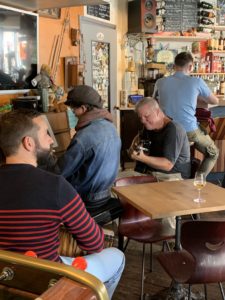
 them and start playing or join into whatever music was happening. George had fun playing guitar with a local piano player, the only language they had in common was music, but they had lot of fun with it.
them and start playing or join into whatever music was happening. George had fun playing guitar with a local piano player, the only language they had in common was music, but they had lot of fun with it.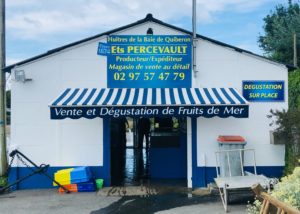
 Brittany, or Little Britain (as opposed to great Britain) was once an independent nation with its own Duke. We visited the
Brittany, or Little Britain (as opposed to great Britain) was once an independent nation with its own Duke. We visited the